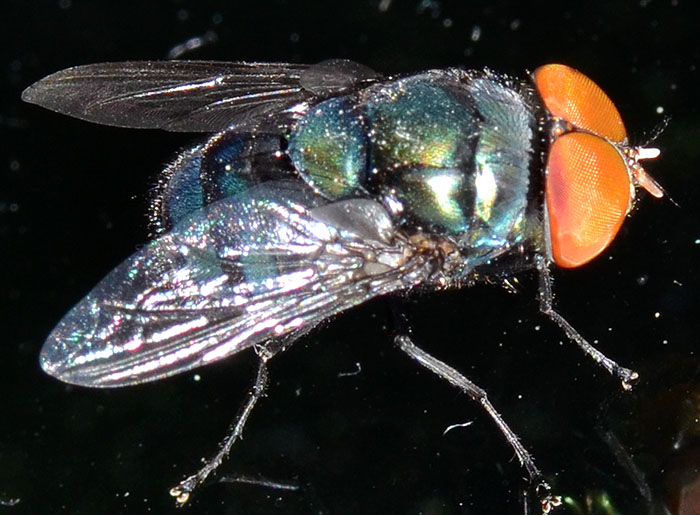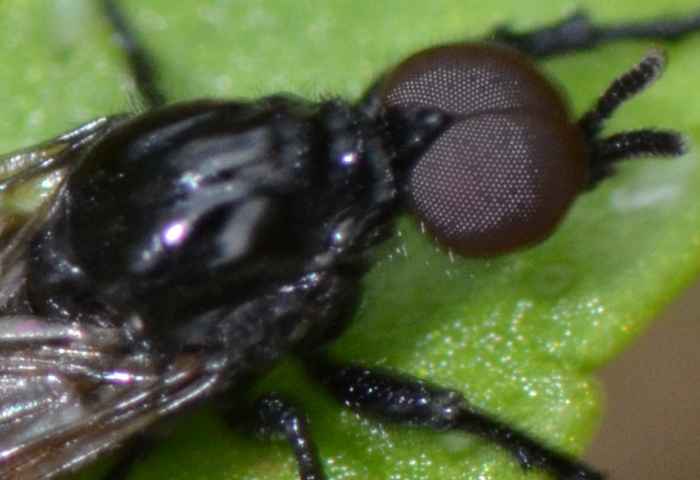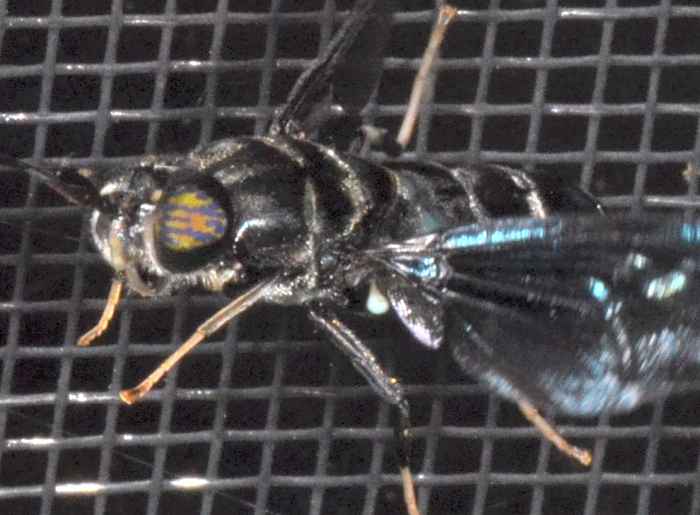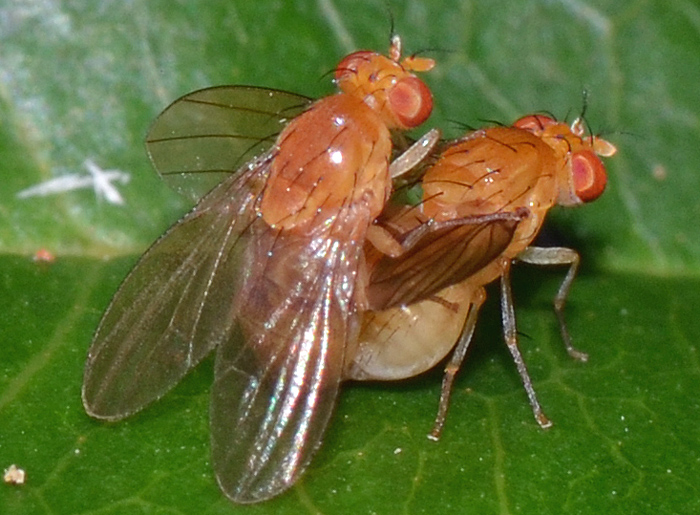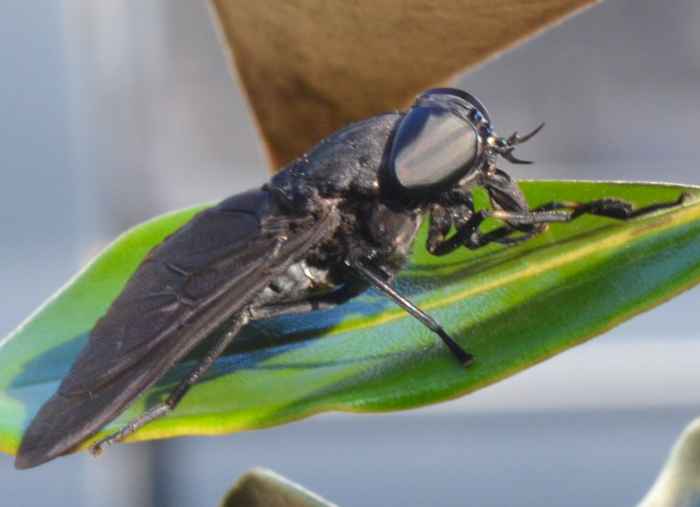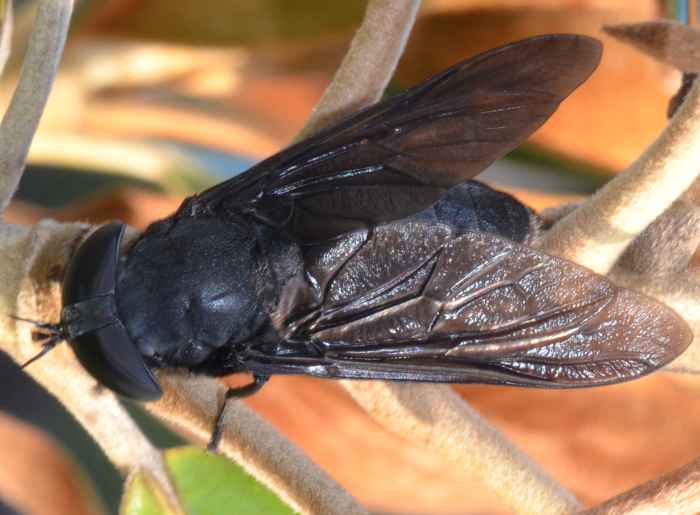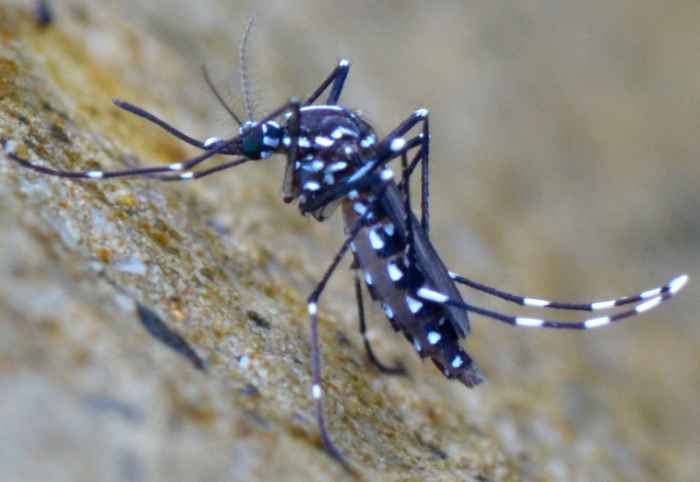 Aedes albopictus (Asian Tiger Mosquito) ♀. | The Asian Tiger Mosquito (Aedes albopictus) was first recorded in Houston in 1985. According to the bug guide it came to the US in used tires shipped from Southeast Asia (good story). In contrast to many other mosquito species, it also flies and feeds during the day. It is also vector for West Nile diseases and other viral pathogens.
bug guide (this photo): http://bugguide.net/node/view/567322 wikipedia: http://en.wikipedia.org/wiki/Aedes_albopictus | ||
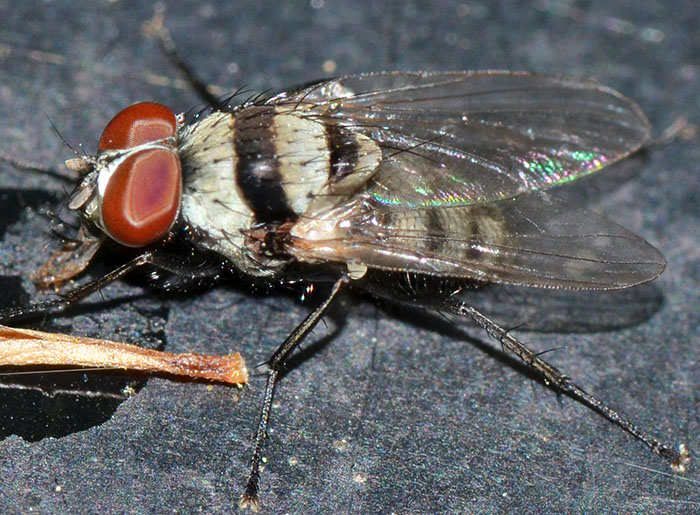 Anthomyia illocata ♂. | This root-maggot fly was introduced from Asia not too long ago, possibly to Florida. While it looks similar to a common small housefly, it has a nearly uniformly broad transverse stripe. bug guide (this photo): https://bugguide.net/node/view/1513762 | ||
 Atomosia puella (Robber Fly). | Robber fly on a pine tree. I believe the head-down position is somewhat characteristic. North America has close to 1,000 different species of robber flies (Asilidae) . They stab and inject other insects with saliva containing enzymes capable of paralyzing and digesting the insides of their victims. One expert on the bug guide suggested that this specimen is Atomosia puella. It has been reported that large robber fly species can kill humming birds bug guide (this photo): http://bugguide.net/node/view/544924 cirrusimage: http://www.cirrusimage.com/Flies_robber.htm Geller-Gimm: http://www.geller-grimm.de/general.htm | ||
 Bibio sp.. | This march fly is Bibio sp. The genus includes more than 50 species in North America. bug guide (this photo): http://bugguide.net/node/view/1205119 | ||
 Bittacomorpha clavipes (Phantom Crane Fly). | This is a crane fly (not a mosquito). It landed prominently on my window and I rushed out to take this picture.
It's most likely a phantom crane fly (Bittacomorpha clavipes) since it has these black and white banded legs. They usually live in swampy areas as their larvae are aquatic. bug guide: http://bugguide.net/node/view/12422 Carnegie Museum: http://iz.carnegiemnh.org/cranefly/ptychopteridae.htm#1 | ||
 Campylocheta townsendi ♂. | This little parasitic fly is Campylocheta townsendi which can only be found in the Southeastern United States. Nearly all members of this subfamily are said to be parasitic on Coleoptera or Lepidoptera larvae.
bug guide (this photo): https://bugguide.net/node/view/1734207 | ||
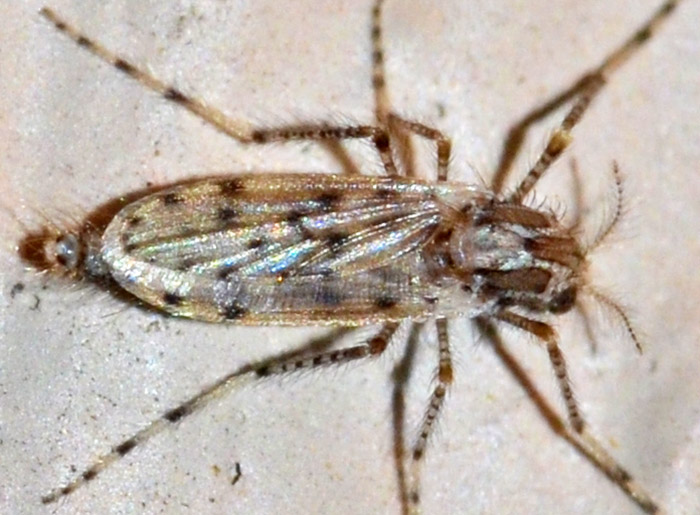 Chaoborus punctipennis ♀. | A little phantom midge with several dark spots on its wings, legs, and also between the stripes on top of the thorax. Its larvae are aquatic and eat zooplankton, whereas the adults do not feed. This is the smallest and most widespread Chaoborus species in North America. The second link contains lots of additional information. bug guide (this photo): https://bugguide.net/node/view/1509047 University of New Hampshire: https://tinyurl.com/chaoborus | ||
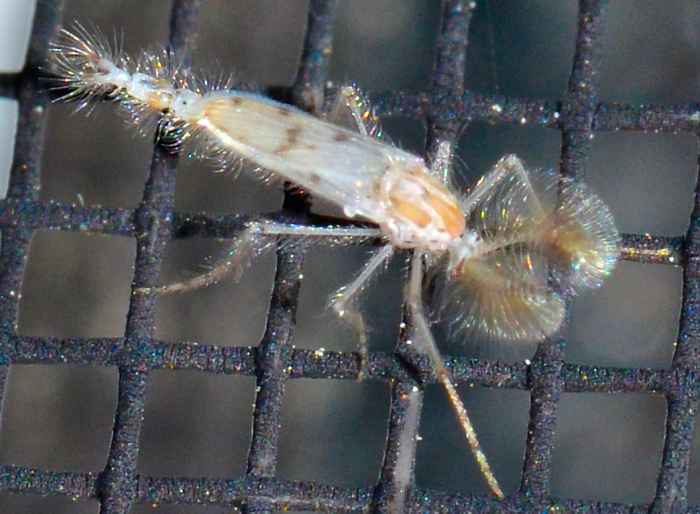 Chaoborus albatus ♂. | One of the few midges with ID. May I introduce to you Mr. Chaoborus albatus? One handsome devil from head to toe. Citing from bug guide: "A small species with spotted wings and legs unmarked except for faint brownish bands at joints." The species C. punctipennis is rather similar, but has more more wing spots and the tibiae and femora are scattered with small black dots.
bug guide (this photo): http://bugguide.net/node/view/633798 | ||
 Chironomus sp. (Non-Biting Midge). | I found this 1/4'' long fly on our front door. It has fancy antennae and a small forked "tail end". This insect is a non-biting midge. I believe it belongs to the Chironomidae family which has 700 known species in North America. Some species have strikingly red, aquatic larvae which are known as blood worms.
This one looks like it could belong to the genus Chironomus. I will list it accordingly but it feels more like guessing. bug guide: http://bugguide.net/node/view/352645 wikipedia: http://en.wikipedia.org/wiki/Chironomidae | ||
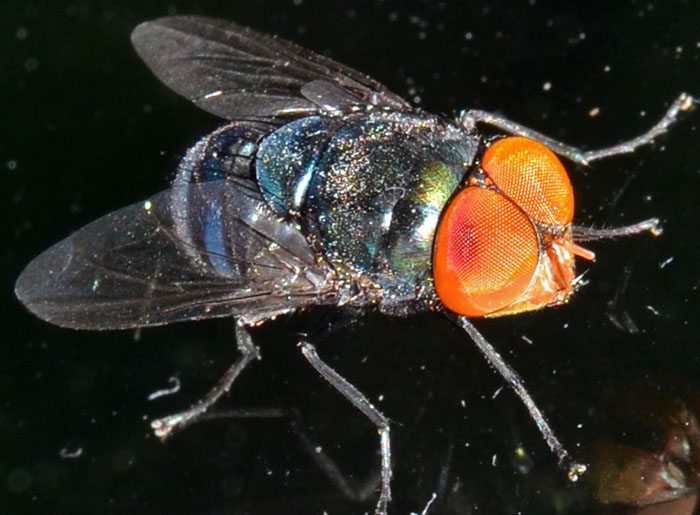 Chrysomya megacephala (Oriental Latrine Fly) ♂. | Wow, we had an oriental latrine fly in our kitchen! Those are rare in our area but rather common in the oriental region and Australia. C. megacephala is a warm-weather fly with a greenish-blue metallic box-like body. The fly infests corpses soon after death, making it important to forensic science. This fly is implicated in some public health issues; it can cause accidental myiasis (parasitic infestation of the body of a live animal by fly larvae).
bug guide (these photos): https://bugguide.net/node/view/1581998 wikipedia: https://en.wikipedia.org/wiki/Chrysomya_megacephala | ||
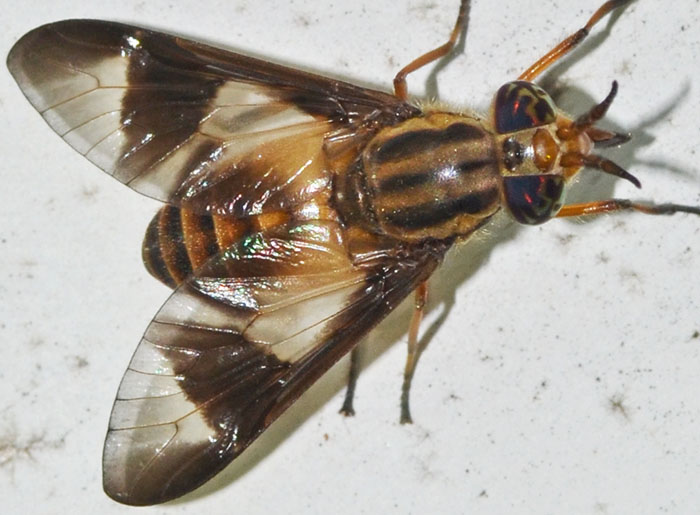 Chrysops sp.. | Nice photos of the deer fly Chrysops sp. The genus has over 100 species in the US alone. The name of the genus refers to the golden coloration of their eyes.
bug guide (these photos): https://bugguide.net/node/view/1514138 Canad. J. Arthropod. Ident. (Key) : https://tinyurl.com/chrysops | ||
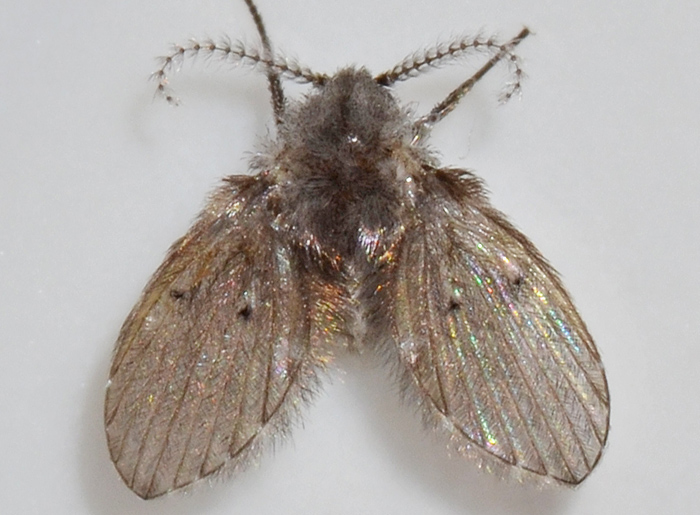 Clogmia albipunctata (Filter Fly). | This moth fly is Clogmia albipunctata which is probably tropical but now found in human habitats throughout most of North America. I noticed this one on our shower wall (the species is also called drain fly). The larvae of all moths in this family live in organic sludge, for example on inner surfaces of drains and sewage pipes. Because of the fine water-repellent hairs covering the flies' bodies, adults are difficult to drown, and are not affected by contact with bleach. Great ... well, I saw only one.
bug guide (this photo): http://bugguide.net/node/view/1208639 wikipedia: https://en.wikipedia.org/wiki/Drain_fly | ||
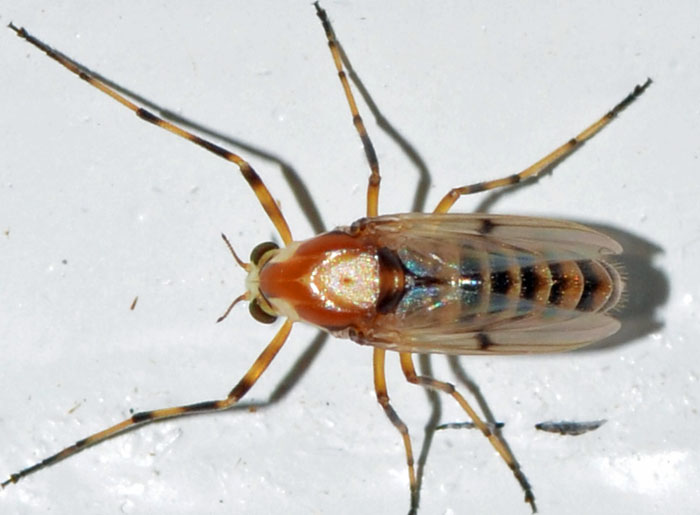 Coelotanypus tricolor ♀. | A cool looking, colorful midge. The genus has at least three species in the eastern half of the country. While overall fairly small, it stood up rather "tall" on the house wall, which immediately caught my attention.
bug guide (this photo): http://bugguide.net/node/view/998154 | ||
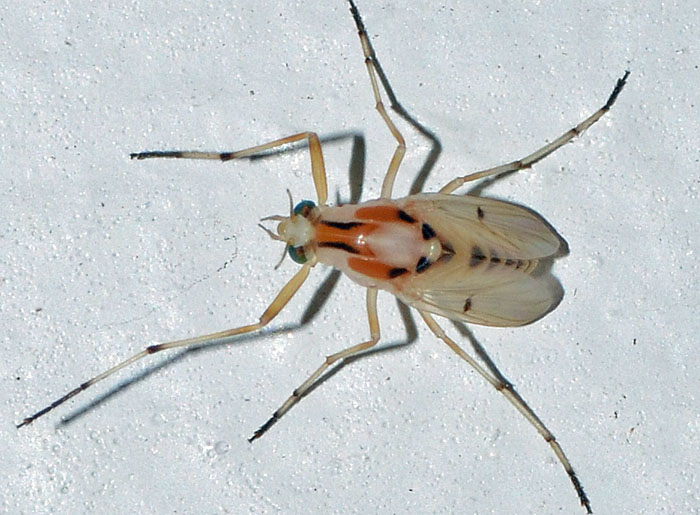 Coelotanypus concinnus ♀. | This pretty midge can be found in near extremely eutrophic (nutrient-rich), medium to large lakes. One translation of the Latin word "concinnus" is actually "pretty". This specimen was clearly not a good walker and its movements looked rather awkward but I do not know whether this feature is characteristic for the species. bug guide (this photo): http://bugguide.net/node/view/1066538 | ||
 Condylostylus sp. (longicornis?) | This little fly is probably Condylostylus longicornis and belongs to the family of Longlegged Flies. To the eye it appears greenish golden with a strong metallic shine. The genus has 35 species in North America. Different species can be found together in very close vicinity. Both photos show females which are more difficult to identify than the (hairier) males.
bug guide (this photo): http://bugguide.net/node/view/559149 bug guide (small photo, 08/17/11 at 9 am): http://bugguide.net/node/view/564223 | ||
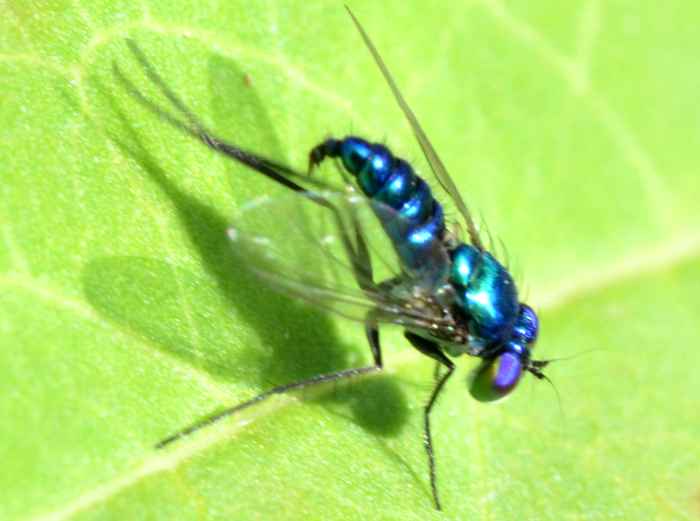 Condylostylus mundus (Longlegged Fly (nonspecific)) ♂. | This blue metallic fly is Condylostylus mundus. Only the males of this species have this striking blue color while the females have the generic green appearance. Both have unmarked wings and entirely black legs. This fly is common in Florida. bug guide (this photo): http://bugguide.net/node/view/568260 | ||
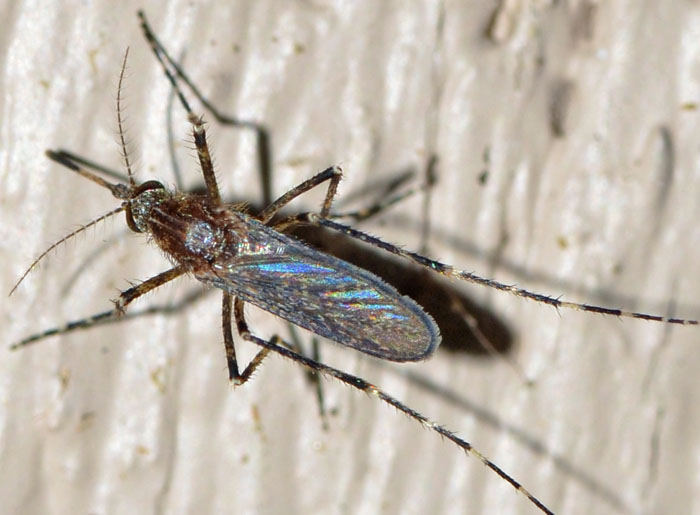 Coquillettidia perturbans (Cattail Mosquito) ♀. | Most likely, a Cattail Mosquito with its characteristic banded legs. The species Coquillettidia perturbans can be found in most parts of the US. Females, like this one, prefer the blood of birds and mammals. They can spread Eastern Equine Encephalitis (EEE) and West Nile Virus (WNV).
bug guide (this photo): http://bugguide.net/node/view/979199 Rutgers: http://www-rci.rutgers.edu/~insects/sp16.htm | ||
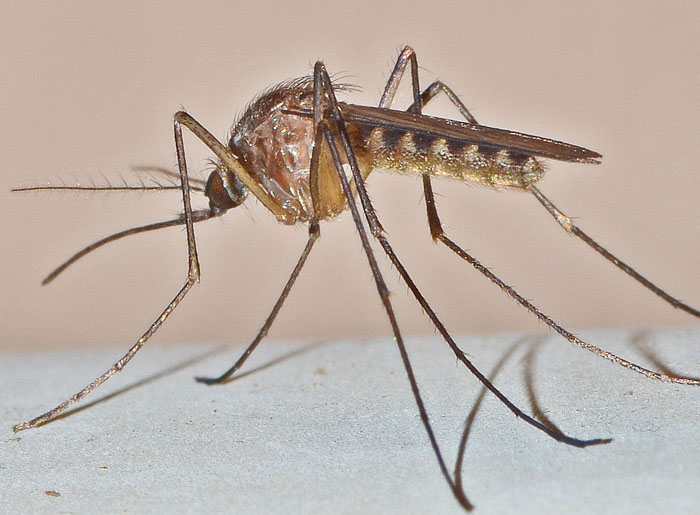 Culiseta sp. ♀. | This female mosquito is Culiseta which has nine species in the US. Most Culiseta species are cold-adapted. C. melanura plays an important role in the transmission cycle of eastern equine encephalitis virus and potentially West Nile virus. The primary victim of blood feeding are birds. bug guide (this photo): http://bugguide.net/node/view/1199252 UF: http://entnemdept.ufl.edu/creatures/aquatic/Culiseta_melanura.htm | ||
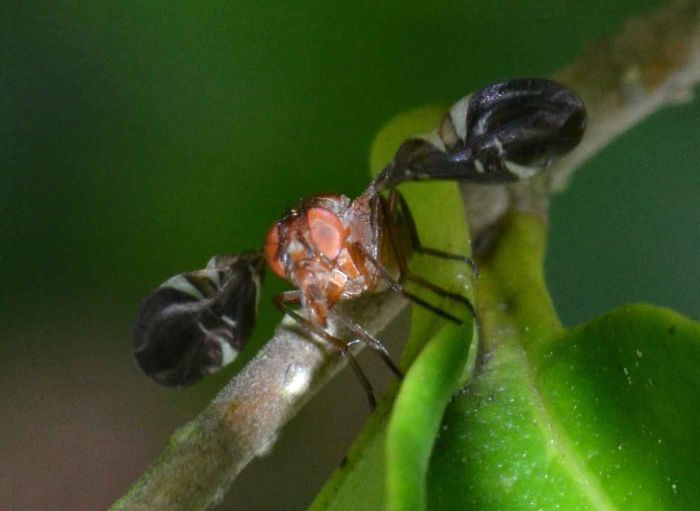 Delphinia picta (Picture-Winged Fly). | I hope that I will see this strange little fly again soon. The quality of this photo is rather poor. I also confused it for a fruit fly. Anyway, it's a Picture-Winged Fly (Delphinia picta) (sometimes also referred to as Camptoneura picta). The fly tends to move its wings in a peculiar rowing motion as it stands still or walks slowly. bug guide: http://bugguide.net/node/view/5919 UF: http://entnemdept.ufl.edu/creatures/misc/flies/delphinia_picta.htm youtube: http://www.youtube.com/watch?v=oMYTBz7YHL0 | ||
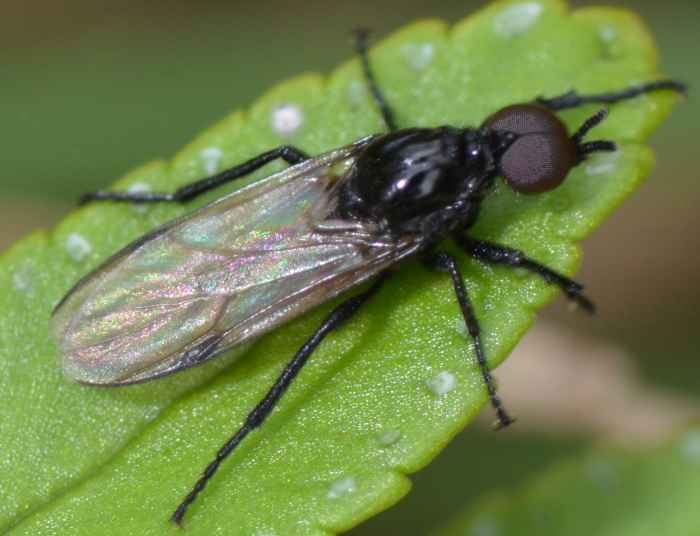 Dilophus sp. (March Fly (nonspecific)) ♂. | This march fly is Dilophus sp. which can be an important pollinator in orchards and the exclusive pollinator of some forms of orchids. The infamous lovebug (Plecia nearctica) is in the same family (Bibionidae).
bug guide (these photos): http://bugguide.net/node/view/603728 | ||
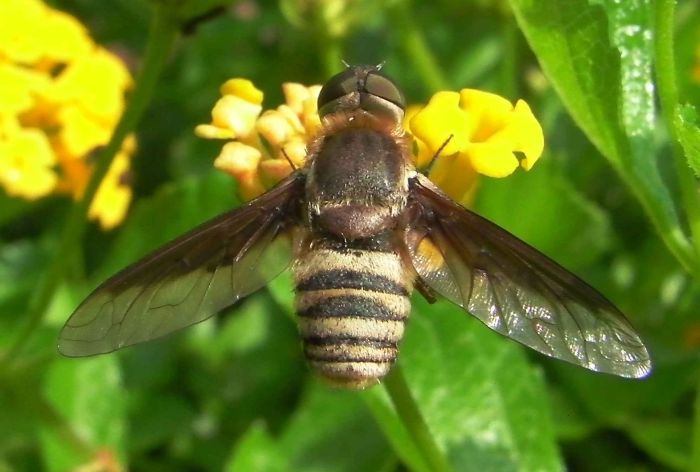 Exoprosopa brevirostris (Bee Fly). | A bee fly on a lantana flower. One of the bugguide experts identified it as Exoprosopa brevirostris (thanks!). I couldn't find much information on this fly but the species name means short beak. The genus has over 40 species in North America. According to Wikipedia there are >4,500 different bee-fly species worldwide. They are "one of the poorest known families of insects relative to its size". bug guide: http://bugguide.net/node/view/535346 wikipedia: http://en.wikipedia.org/wiki/Bombyliidae | ||
 Hermetia illucens (Black Soldier Fly). | The Black Soldier Fly (Hermetia illucens) can be found in most areas of North America. It is large and black with shiny, blueish wings. It is clearly a wasp mimic and buzzes like a wasp. According to the second link this fly "does not have mouthparts and does not feed upon waste. They do not bite, and as only the larva feed, are not associated with transmitting any diseases. Also, this species makes the breeding areas of houseflies less desirable."
bug guide (these photos): http://bugguide.net/node/view/660710 Texas A&M University: http://alturl.com/hpakw | ||
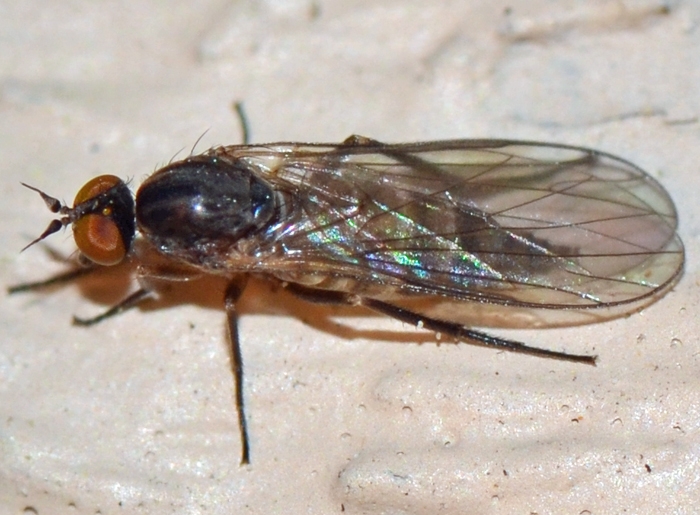 Hilara sp. (Balloon Fly). | There are 50 described species of balloon flies in North America. The genus belongs to the family Empididae which includes small to medium sized flies that are usually elongated and mostly dark colored. bug guide (this photo): http://bugguide.net/node/view/1351747 | ||
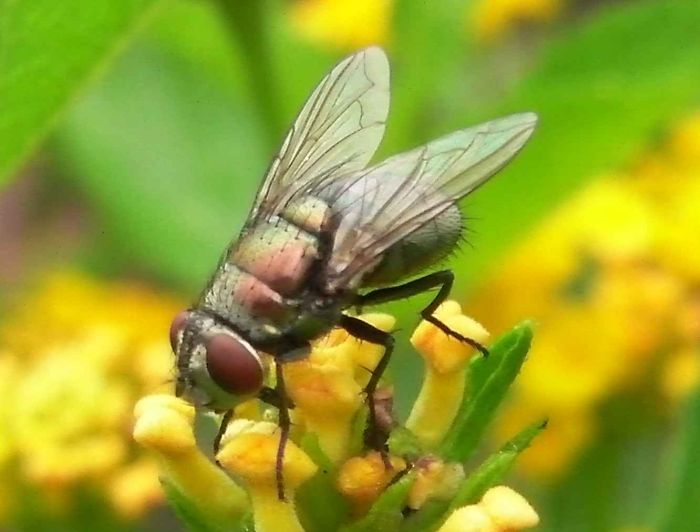 Lucilia sp. (Blow Fly). | This is the very common Blow Fly or Green Bottle Fly (Lucilia sp.). There are 11 species in North America, which are--at least for me--very difficult to distinguish. bug guide (this photo): http://bugguide.net/node/view/546611 wikipedia: http://en.wikipedia.org/wiki/Green_bottle_fly | ||
 Mallochohelea sp. (?) (Biting Midge). | Small biting midge; the best guess for the genus is Mallochohelea. I'm citing from the bug guide page in the link below "(...) females in this tribe hunt for males. The male is usually eaten while mating." The family Ceratopogonidae is also known as "punkies" and "no-see-ums". Adult females suck blood from insects and other animals including humans. bug guide: http://bugguide.net/node/view/437729 | ||
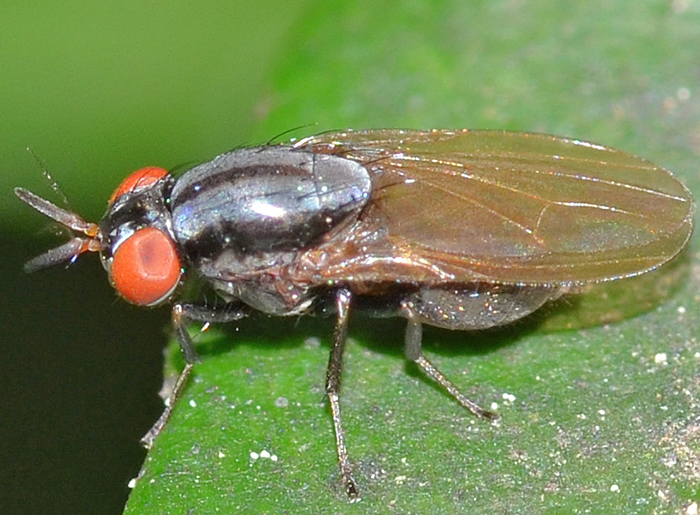 Melanomyza sp.. | Just another small fly from the Lauxaniidae family. bug guide (this photo): https://bugguide.net/node/view/1354672 | ||
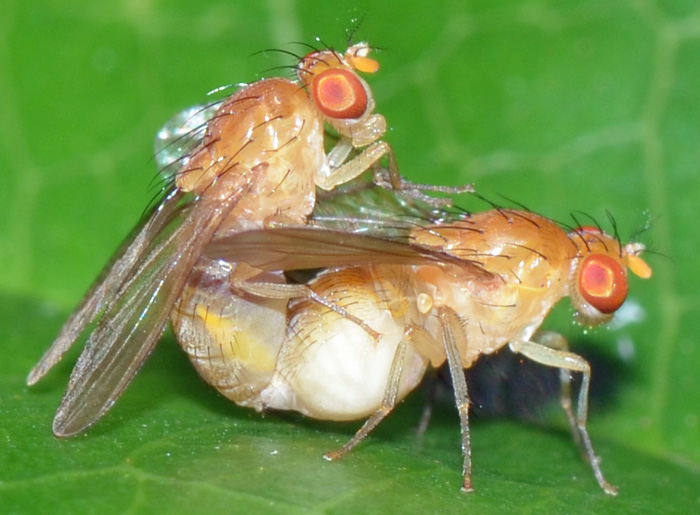 Neogriphoneura sordida. | N. sordida is the only Nearctic species in this genus. It can be found from Virginia to Florida and Texas.
bug guide (these photos): http://bugguide.net/node/view/937981 | ||
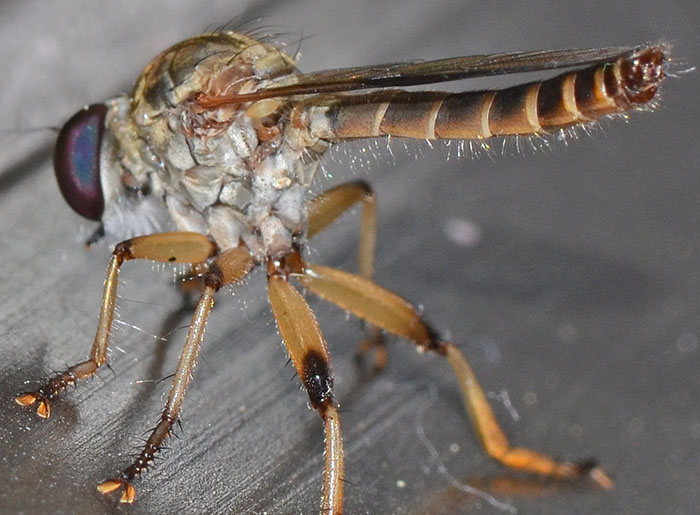 Ommatius sp. ♂. | The genus has 13 species in North America and over 300 worldwide. I found this one on our window frame and admittedly it looked rather dead or perhaps it was just taking a break from the stressful life of being a robber fly. bug guide (this photo): http://bugguide.net/node/view/1365920 | ||
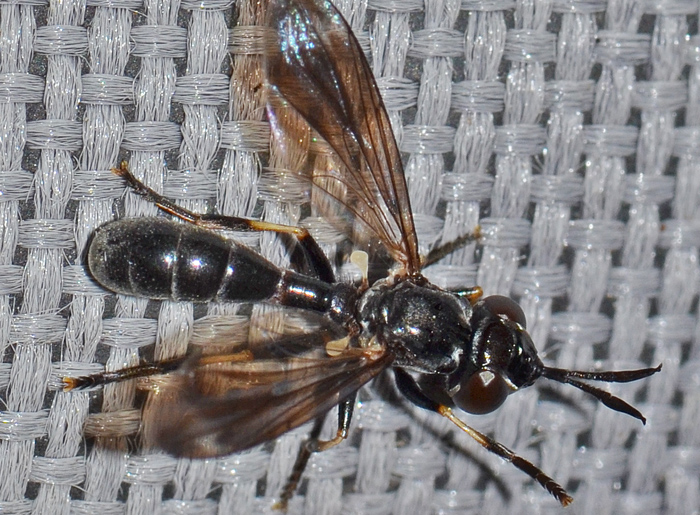 Physoconops sylvosus. | Thick-headed flies (Conopidae) often mimic thread-waisted wasps. The conopid flies are solitary and typically internal parasites of Hymenoptera (especially wasps and bees). This specimen is in the subgenus Gyroconops which in the US has only one species. Apparently a rare find! bug guide (this photo): http://bugguide.net/node/view/1247889 | ||
 Plecia nearctica (Lovebug). | There are two species of lovebugs in North America. This one is Plecia nearctica. Adults feed on nectar. Copulating adults often form swarms. Females live approximately one week; males 2-3 days. This species has two generation in Florida that peak in April/May and August/September. P. americana appears only in Spring approximately 2-3 weeks before P. nearctica.
bug guide (these photos): http://bugguide.net/node/view/570738 UF: http://edis.ifas.ufl.edu/in204 | ||
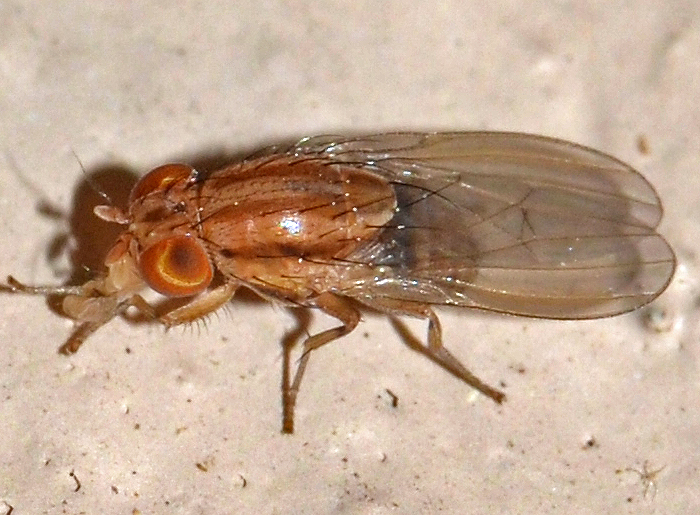 Poecilominettia valida. | In the US, this genus has six different species, worldwide at least 60. bug guide (this photo): https://bugguide.net/node/view/1547331 | ||
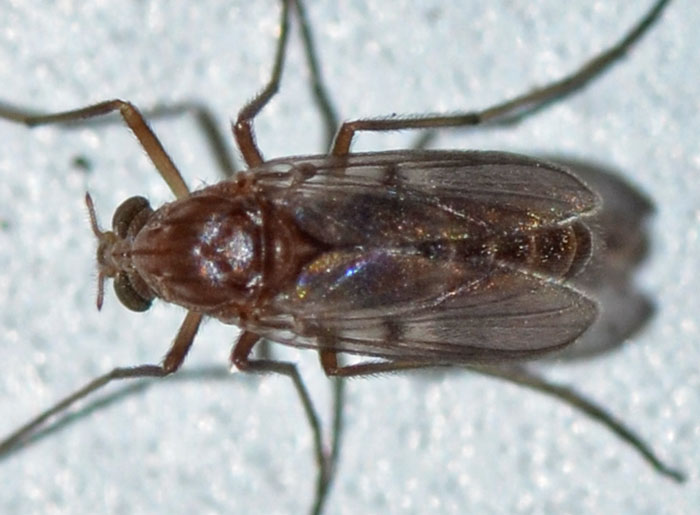 Procladius sp. ♀. | This midge belongs to the subgenus Holotanypus. Its members are generally brownish, thus distinguishing them from the brightly colored P. bellus and the black Procladius (Psilotanypus) subgenus. Identification of the actual species is exceedingly difficult.
bug guide (this photo): http://bugguide.net/node/view/1364800 | ||
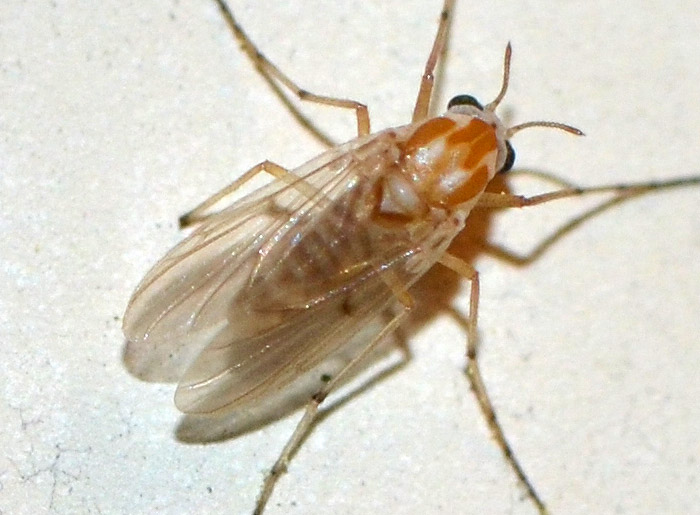 Procladius bellus ♀. | Rare find for the Southeast and I am quite happy with the image quality given that this little midge measures only 2-3 mm. Like its sister species, P. bellus prefers mud bottoms and are more often found near ponds and slow-moving water bodies. bug guide (this photo): https://bugguide.net/node/view/1506217 | ||
 Ptecticus sp.. | Ptecticus is an Old World genus of flies in the family of soldier flies. The main color of the body may be yellow, brown or black, and the abdomen often shows a degree of transverse stripes. They may mimic parasitic wasps in appearance and habits. The wings are often dusky and the second abdominal segment may be translucent. Their larvae are broad, flat and segmented maggots, which may be found in fermenting fruit. bug guide (this photo): https://bugguide.net/node/view/1415450 wikipedia: https://en.wikipedia.org/wiki/Ptecticus | ||
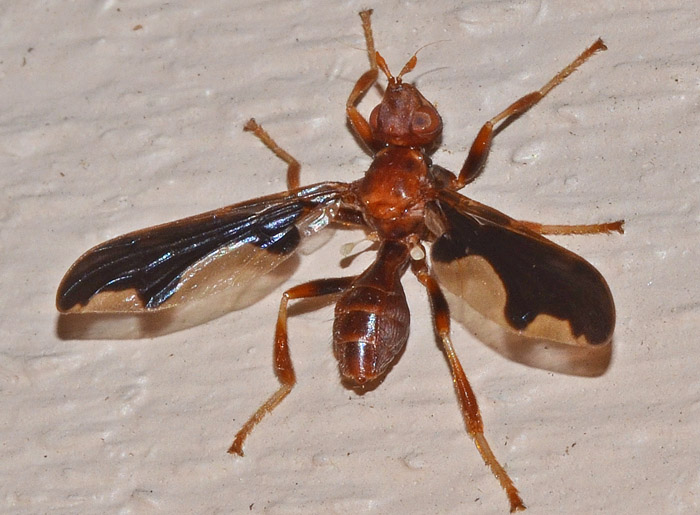 Pyrgota undata (Waved Light Fly). | Now this is crazy ... the females of this species land on May beetles causing them to take flight. Then the fly lays an egg into the beetle's back while soft parts are exposed during flight. Flies usually attack female beetles only and may pursue them under lights. The larvae are about 1 cm long and kill the host beetle after about two weeks to finally consume the entire interior. The fly pupates inside the host remains and emerges following spring.
bug guide (this photo): http://bugguide.net/node/view/1080363 | ||
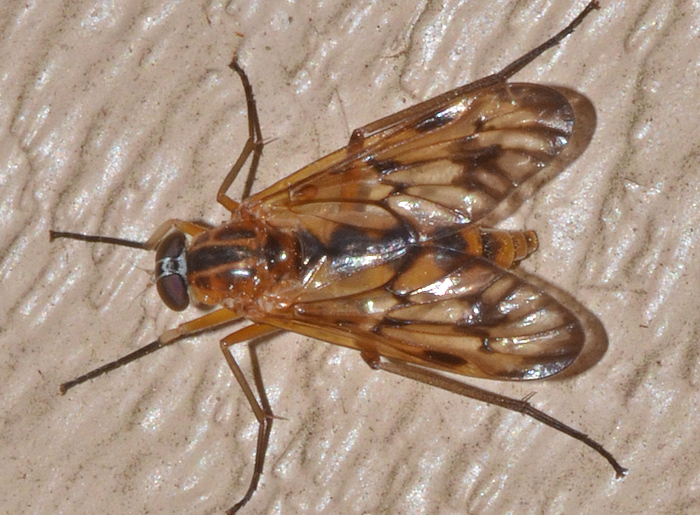 Rhagio albicornis. | This photo shows a predatory snipe fly. Rhagio has 25 species in North America. Several species in this genus are called down-looker flies because they sometimes perch on tree trunks in a head-down position. bug guide (this photo): http://bugguide.net/node/view/1205765 | ||
 Sarcophaga sp. (Flesh Fly). | The 'flesh fly' doesn't have a great reputation but it is obviously a very useful insect. Its genus Sarcophaga has about 80 species in North America, which are extremely difficult to distinguish. They have grayish/black stripes on their thorax, which become checkered on the "tail end". They lay their eggs in decaying animals or excrement. Within a few days the eggs turn into maggots which burrow into the soil, pupate, and wait for spring to arrive. Let's move on. wikipedia: http://en.wikipedia.org/wiki/Flesh-fly | ||
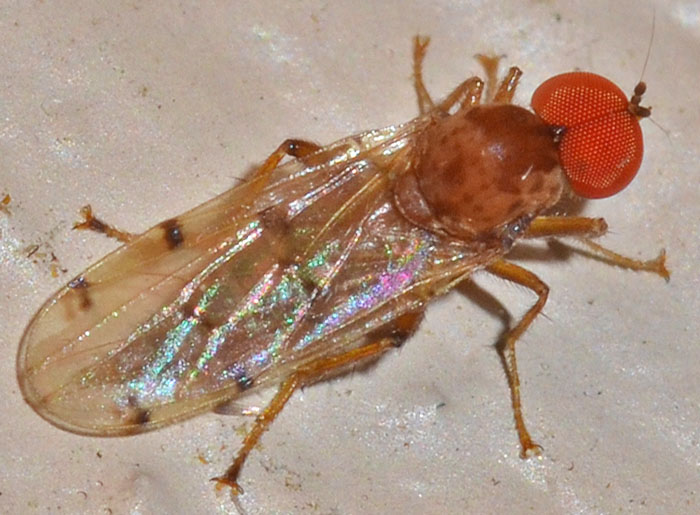 Syneches simplex. | Although this dance fly is fairly small, it immediately caught my attention because of its striking orange eyes. The bugguide states: "It is the only regional species of Syneches with two spots on each wing, one at the apex of each of the first two long veins."
bug guide (this photo): http://bugguide.net/node/view/1056739 | ||
 Tabanus atratus (Black Horse Fly). | A huge and entirely black fly with scary mouth parts that are used to slice the skin of victims. Female flies lap up blood while males drink nectar. The second link describes the bites as very painful and notes that this fly tends to target livestock and horses more than people.
bug guide (these photos): http://bugguide.net/node/view/566746 Dave's Garden: http://davesgarden.com/guides/bf/go/398/ Steve Murphree: http://www.tn.gov/environment/tn_consv/archive/flies.pdf | ||
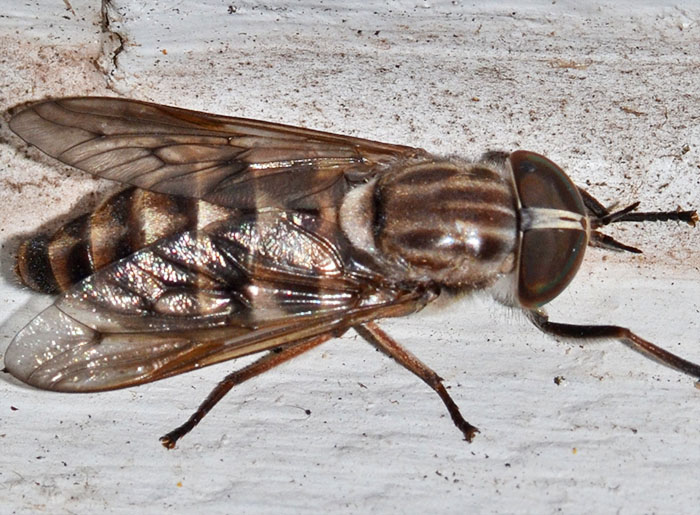 Tabanus sp. ♀. | A less intimidating, biting horse fly from the Tabanus genus which has more than 100 species in the US. The eye-gap gives away that this specimen is a female. bug guide (this photo): https://bugguide.net/node/view/1375166 | ||
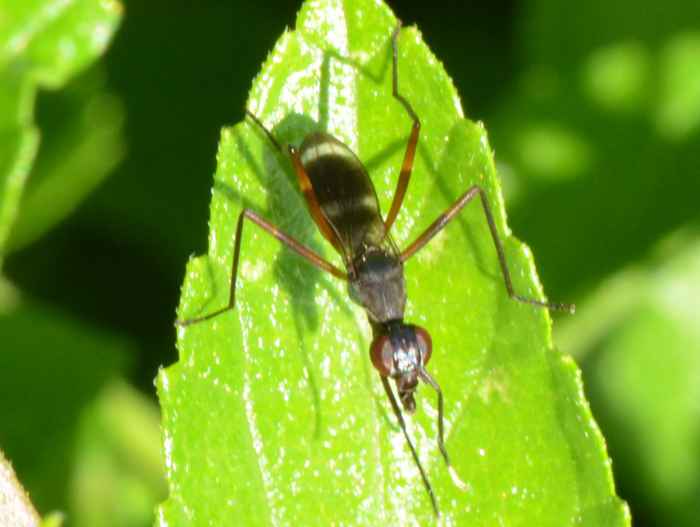 Taeniaptera trivittata | This Stilt-Legged Fly (Taeniaptera trivittata) looks and acts very much like an ant. It holds the front legs up like long antennae to distract from its short fly antennae. It was dashing over the leaves and difficult to photograph. The wings remind me of a wasp. The tips of the front legs are white. The genus has three species in the Southern states. The small photos show other stages.  A short video is available on my YouTube channel. A short video is available on my YouTube channel.bug guide (this photo): http://bugguide.net/node/view/564224 insects of WV: http://www.insectsofwestvirginia.net/f/taeniaptera-trivittata.html | ||
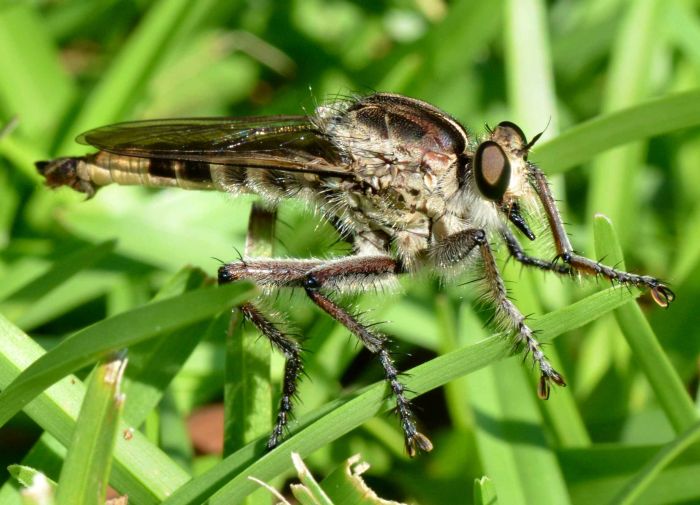 Triorla interrupta (Robber Fly) ♂. | Triorla interrupta. This pretty big robber fly often kills even larger insect prey including grasshoppers and dragonflies. It likes open grassy terrain. This specimen has been identified as a male on the bug guide. bug guide (this photo): http://bugguide.net/node/view/548299 Herschel Raney: http://www.hr-rna.com/RNA/Rfly%20pages/Triorla%20page.htm | ||
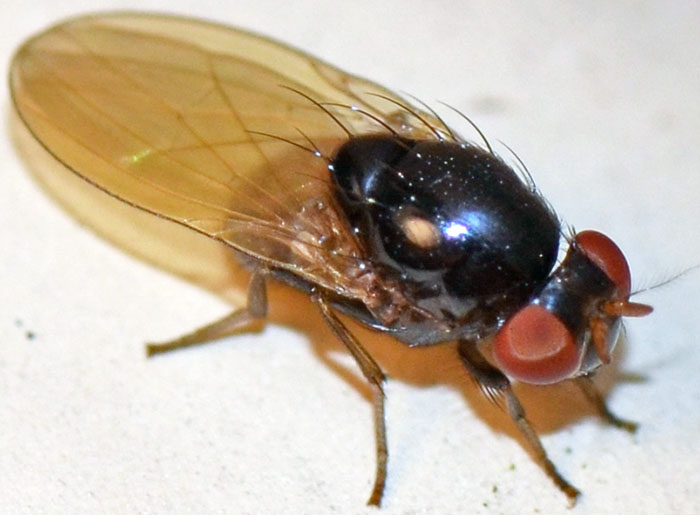 Xenochaetina sp.. | Small shiny fly with orange/amber-colored wings and red eyes. Quoting from bugguide.net "Although only one species is recorded from North America, the true number of species and their names are uncertain." The small photo shows the same specimen.
bug guide (these photos): http://bugguide.net/node/view/1448668 | ||
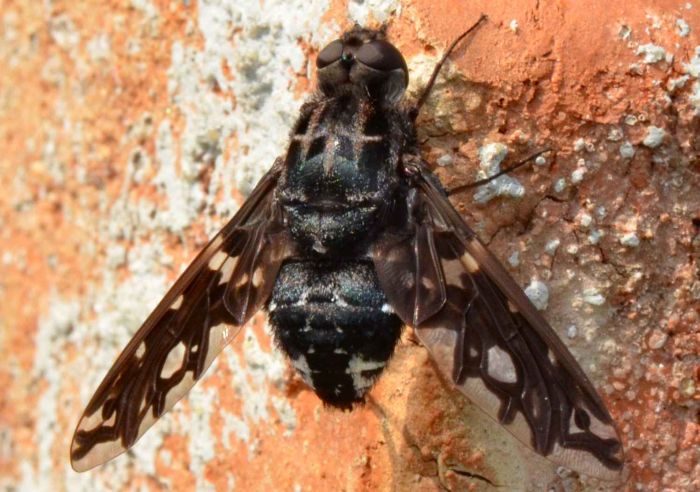 Xenox tigrinus (Tiger Bee Fly). | Tiger bee fly (Xenox tigrinus). As name suggest this large and striking insect belongs to the bee flies (Bombiliidae). This species is fairly common in eastern states. The larvae of X. tigrinus parasitize large carpenter bees. bug guide (this photo): http://bugguide.net/node/view/549195 Matt Simon: http://wildparty.typepad.com/home/insecta-flies-beeflies-diptera-bombyliidae/ |


